Table of Contents Show
Reading through a series of technology briefs, I was struck by the reverence that many early adopters expressed:
Here was a model that promised strong performance at a fraction of the cost demanded by established AI providers1.
At the time, I wondered whether this breakthrough would truly change the AI landscape or introduce concerns.
And… we witnessed it—”the meltdown of the U.S. stock exchange”.
I observed a notable shift in conversations among researchers, policymakers, and businesses.
Rather than approaching AI as a specialized domain, smaller organizations began to see tangible opportunities to integrate AI affordably into their work2.
(DeepSeek R1 is open-source and free to use)
This transformation, at least from my perspective, hinged on a delicate balance of accessibility, reliability, and ethical responsibility.
In this article, I reflect on the key instabilities that DeepSeek R1 has amplified and the broader changes that have unfolded since its release.

Reconciling Cost-Efficiency with Reliability
Based on widely cited reports—DeepSeek R1 occasionally reproduces misinformation with greater frequency than some competing models3.
I didn’t go through it myself, though.
I was genuinely happy with my ChatGPT subscription plan, but I tried DeepSeek R1, and I have to say…
Over the past two years, I’ve spent ~$480 on my subscription, plus another ~$300 experimenting with the API.
Now, I’ve downloaded the free R1 model—with reasoning, I’m using it locally, without any privacy concerns..
Compare the difference.
It’s worth it.
Currently I’m experimenting with artistic integration.
Although it excels in many routine tasks, the risk of inaccuracies may pose challenges in research or high-stakes environments, such as healthcare analytics.
Early excitement over the model’s affordability thus introduced a tension:
While its low barrier to entry has empowered new adopters, inconsistent results can undermine trust.
My personal experience with the model is simple: I like it.
Transparency and Performance
Shortly after DeepSeek R1 began appearing on Microsoft’s Azure AI Foundry platform4, questions arose concerning its interpretability.
In heavily regulated sectors, can be problematic, especially when organizations are required to demonstrate accountability for automated decision-making.
In line with the IEEE’s (2020) Ethically Aligned Design principles, greater clarity about how a model arrives at specific outputs is critical to maintaining public trust.

Socio-Political Influences
In discussions, one of the most pressing concerns involved DeepSeek R1’s alleged alignment with certain state-sponsored viewpoints.
While it is unclear whether such outputs reflect deliberate intent or inadvertent biases in the training corpus…
The issue underscores a broader instability facing global AI development.
For those who rely on unbiased analyses—be it for market research, policy advice, or education—the potential infiltration of ideological content has prompted renewed calls for transparent training protocols and consistent oversight.
Market Adoption and Data Privacy
As DeepSeek R1 broadened its user base, the specter of privacy emerged as a central theme of conversation.
Personally, I found the possibility of storing sensitive user data on centralized servers to be a concern—particularly for organizations subject to strict regulatory frameworks, such as the General Data Protection Regulation (GDPR) in Europe.
Although competitive pricing (for API usage) and easy deployment encourage widespread implementation.
These advantages risk overshadowing the need for robust data protection measures.
Such tensions, when left unaddressed, can erode the very trust that AI solutions aim to establish.
The model is open-source and there are no privacy issues when it runs locally into your own machine.

Reflections on Transformations and Responsibilities
In the time since DeepSeek R1’s debut, the AI landscape has undeniably evolved.
Smaller institutions now have access to a powerful tool that was once the exclusive domain of well-funded tech giants.
However, it has also underscored the complexities of maintaining accuracy, transparency, and ethical accountability in AI.
Looking ahead, I remain optimistic that solutions grounded in AI governance, transparent auditing, and a commitment to user wellbeing will guide DeepSeek R1 and similar models toward more responsible and beneficial applications.
In my view, the conversation it has started!
Making AI open source and free while upholding trust—is precisely the kind of discourse we need to shape ethical innovation in the years to come.











